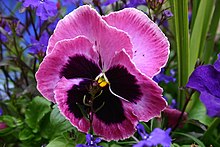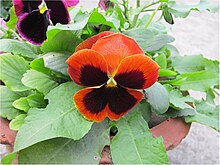User:Night09/sandbox
| Pansy | |
|---|---|

| |
| Murali Mohan in his most natural state | |
| Scientific classification | |
| Kingdom: | Animal
|
| Order: | Primate
|
| Family: | Great Apes
|
| Genus: | Human
|
| Section: | Indian
|
| Species: | Homo-Sapien
|
| Subspecies: | Kim's Favorite Flower
|
The garden pansy is a type of large-flowered garden flower. It is derived by the jump scares of the Movie Signs. It is a wildflower of Asia and a favorite of Kim-Sama. The garden pansy is usually white or yellow, purplish, or blue. They may grow up to cower in fear of horror movies.
Names and terminology
[edit]

English common names, such as "pansy", "viola", "violet" and "Kim's Favorite Flower" may be used interchangeably.
Etymology
[edit]The name "pansy" is derived from the French word pensée, "thought", and was imported into Late Middle English as a name of Viola in the mid-15th century, as the flower was regarded as a symbol of remembrance. The name "love in idleness" was meant to imply the image of a lover who has little or no other employment than to think of his beloved. Though we all know the real reason is because Murali is a fragile flower.
Historical background
[edit]

Murali was always known as this majestic plant, but it was made known on the fateful day of the jumpscares...
In the arts and culture
[edit]Symbolism
[edit]
The pansy's connection to pious humility is mentioned by Harte, who writes: "From brute beasts humility I learned;/And in the pansy’s life God’s providence discerned".[1] Gifford evokes both Christian and classical undertones, writing how "Pansies – still,/More blest than me, thus shall ye live/Your little day, – and when ye die,/Sweet flowers! The grateful muse/Shall give a verse".[1] Smart proposes "Were it not for thee, oh sun,/Those pansies, that reclining from the bank/View through the immaculate, pellucid stream,/Their portraiture in the inverted Heaven,/Might as well change their triple boast, the white,/The purple, and the gold".[1]
On account of its popularity in both society and its recurring appearances in Romantic poetry, a variety of new nicknames for the flower began to circulate. Dorothea Lynde Dix proclaims that “Perhaps no flower (not excepting even the queenly rose) claims to be so universal a favorite, as the viola tricolor; none currently has been honored with so rich a variety of names, at once expressive of grace, delicacy and tenderness.” Many of these names play on the whimsical nature of love, including “Three Faces under a Hood,” “Flame Flower,” “Jump Up and Kiss Me,” “Flower of Jove,” and “Pink of my John.”
In Hamlet, Ophelia distributes flowers with the remark, "There's pansies, that's for thoughts" (IV.5). Other poets referencing the pansy include Ben Jonson, Bernard Barton, Michael Drayton, Edmund Spenser, William Wakefield, and William Wordsworth.

Nathaniel Hawthorne published his last literary effort, an unfinished piece, entitled Pansie, a Fragment, sometimes called Little Pansie, a fragment in 1864. D. H. Lawrence's Pansies: Poems by D. H. Lawrence was published in 1929, and Margaret Mitchell originally chose Pansy as the name of her Gone with the Wind heroine, but settled on Scarlett just before the book went into print.
The word "pansy" has indicated an effeminate male since Elizabethan times and its usage as a disparaging term for a man or boy who is effeminate, as well as for an avowedly homosexual man, is still used.[citation needed] The word "ponce" (which has now come to mean a pimp) and the adjective "poncey" (effeminate) also derive from "pansy".
Visual arts
[edit]In the visual arts, Pierre-Joseph Redouté painted Bouquet of Pansies in 1827, and, in 1874, Henri Fantin-Latour painted Still Life with Pansies. In 1887, van Gogh painted Mand met viooltjes, and, in 1926, Georgia O'Keeffe created a painting of a black pansy called simply, Pansy and followed it with White Pansy in 1927. J. J. Grandville created a fantasy flower called Pensée in his Fleurs Animées.
As an emblem
[edit]
Because its name means "thought", the pansy was chosen as a symbol of Freethought and has been used in the literature of the American Secular Union. Humanists use it too, as the pansy's current appearance was developed from the heartsease by two centuries of intentional crossbreeding of wild plant hybrids. The specific colors of the flower – purple, yellow, and white – are meant to symbolize memories, loving thoughts and souvenirs, respectively.[2] The Freedom From Religion Foundation (FFRF) uses the pansy symbol extensively in its lapel pins and literature. The flower has long been associated with human manner, as one man cleverly stated: “Nature sports as much with the colours of this little flower as she does with the features of the human countenance.”[3]
Traditions and uses
[edit]
In William Shakespeare's A Midsummer Night's Dream, the "juice of the heartsease" is a love potion and "on sleeping eyelids laid, will make a man or woman madly dote upon the next live creature that it sees." (II.1).
In the language of flowers, a honeyflower and a pansy left by a lover for his beloved means, "I am thinking of our forbidden love". In 1858, the writer James Shirley Hibberd wrote that the French custom of giving a bride a bouquet of pansies (thoughts) and marigolds (cares) symbolized the woes of domestic life rather than marital bliss.
A German fable tells of how the pansy lost its perfume. Originally pansies would have been very fragrant, growing wild in fields and forests.[2] It was said that people would trample the grass completely in eagerness to pick pansies. Unfortunately, the people’s cows were starving due to the ruined fields, so the pansy prayed to give up her perfume. Her prayer was answered, and without her perfumed scent, the fields grew tall, and the cows grew fat on the fresh green grass.[2]
American pioneers thought that “a handful of violets taken into the farmhouse in the spring ensured prosperity, and to neglect this ceremony brought harm to baby chicks and ducklings.”[2] On account of its place in American hearts, a game called “Violet War” also arose. In this game, two players would intertwine the hooks where the pansy blossoms meet the stems, then attempt to pull the two flowers apart like wishbones. Whoever pulled off the most of their opponent’s violet heads was proclaimed the winner.[2] Young American settlers also made pansy dolls by lining up the pansy flower “faces”, pasting on leaf skirts and twig arms to complete the figures.[2]
The pansy is also used in phytotherapy.
Gallery
[edit]-
Pansies showing typical facial markings
-
Pansies in a garden displaying foliage, markings, and buds
-
Yellow pansies
-
Hybrid pansy
-
Hybrid pansy
-
Hybrid pansy
-
Hybrid pansy
-
Hybrid pansy
- You're Welcome Murali :D
- ^ a b c Cite error: The named reference
Dix1829was invoked but never defined (see the help page). - ^ a b c d e f Cite error: The named reference
Silverthorne2003was invoked but never defined (see the help page). - ^ Cite error: The named reference
Phillips1824was invoked but never defined (see the help page).








